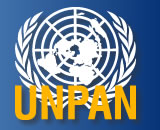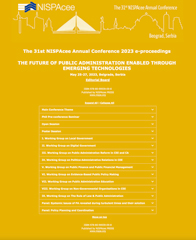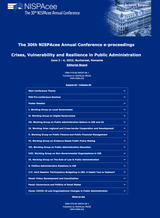| WG_News :: About WG :: Coordinators :: Activities :: WG_outputs |
Local government finance in the times of crisis:
How to respond?
Research Protocol 2010
Goals, Aims and Objectives of the Proposed Research
In all CEE and CIS countries the transformation of the planning economy has phased some rates of decentralisation of the state. Different segments of this topic have already been discussed by the working group in the past, like: grant transfers (Cracow 2001), local government revenue raising capacity (Bucharest 2003), user fees and charges (Vilnius 2004), local borrowing (Ljubljana 2006), property taxation (Bratislava 2008) and municipal asset management (2009).
The evaluated processes, the individual country and local cases – with some particular exceptions – have usually happened after a big shock of the economy by turning from the command economy towards market economy first, and after in a take off of the world economy and national economies over the last decade. This process has broken both in the advanced and emerging economies since autumn 2008. A new and deep world wide financial and economic crisis has started. The decreasing economic achievements strongly effects public finance including local government finance by decreasing government revenues (less central and local tax revenues) and increasing social pressure (fast growing unemployment rate).
Like market organisations the government sector is also working in a changing environment. That is why the change management became a very important topic for organisational management in the private sector first and slowly in the public sector, too. To handle the present situation rather requires crises management than a “simple” change management in most countries. It means drastic interventions regarding government spending both on the national and local level, too.
Crisis reached the countries belonging to CEE and CIS world at different stages of decentralisation and the condition of the national economy. Localities are affected less or more heavily by the crisis. It results different actions, interventions country to country and municipality to municipality. The main goal of this research is to examine the effects of the actual world wide financial and economic crises to local government finance and identify the central and local answers (best practices) to that situation at different conditions of the national economy and different stages of decentralisation. The target area is CEE and CIS countries but case studies from advanced economies are also welcomed. There is a particular interest regarding those countries which required loan from IMF and/or the European Union to avoid the bankruptcy of the country.
The final outcome of the research should be 10-12 country and local case studies using this protocol and presented in Warsaw in 2010, and issued in a book in 2011. Case studies will be summarised in a comparative study as a first chapter of the book which also publishes the final version of all accepted case studies.
Structure of the country papers
The papers have to be up to 12,000 words long (including references and appendices). The authors highly encouraged to be prepared to produce a shorter version of up to 8,000 words as journal articles. Please, try to adhere to the set limit, as this enables preparation of any intended future publication.
As for the style of the paper, please, follow, the NISPAcee Manuscript Guidelines (http://www.nispa.org/portal/files/conferences/2007/Nispacee_Manuscript_Guidelines_2007.pdf)
Papers should have the following structure:
1. Introduction
In the introduction the authors have to clearly set out the goals, aims and objectives of their research, what might be the main issues (research questions) that they plan to tackle and how this is going to be done, with a list of expected outcomes. It is acceptable to discuss very briefly the main problems dealt with in literature and how this may relate to their research. It is expected that all authors will demonstrate a very good knowledge of related literature in both local language and in English. At the end of the introductory section the author should set out the remaining of the paper (paper structure).
2. Nature of the crises
This chapter should describe the level of decentralisation at the beginning of the crisis and the general effects of the crisis in each country. The relative importance of Central and Local Government related to the GDP, additionally the rate of own revenue sources in the total local government revenues may indicate the level of fiscal decentralisation. The general effect of the crises should evaluate by the change of macro economic indicators like GDP (and per capita GDP at PPP), unemployment rate, inflation rate, exchange rate (related to EUR or USD), trade balance, number of enterprises etc.
The time frame for this evaluation is 2006-2011:
- fact figures of the last three years (2006-2008),
- estimation of the year 2009 and possibly
- the forecasting of the next two years (2010-2011)
Related to CEE and CIS countries it is supposed to make a comparison on the loss of economy between the period of the beginning of the transition (late 1980s and early 1990s) and the actual financial and economic crisis. For the cases of advanced economies this comparison is supposed between the period of the Oil Price Shock (mid 1970s) and the present situation.
3. Case study
The core research question is that how to public sector respond to the actual crisis. There are two possible approaches to work out the case for the contributors: top-down or bottom-up. They can choose one from these possibilities.
The top-down approach discusses the actions taken by the national government to handle the crisis. The previous world wide crises – the World Economic Crisis in 1929-1933 and the Oil Price Shock in the mid 1970s – increased the role of the state to eliminate market failures. Within the region the Transition has been a process of decentralisation of an entirely centralised political and economic system. What are the reactions to the actual crisis in individual countries: increasing concentration of power (fiscal capacity) on the level of Central Government or increasing role of decentralisation among the government levels and/or between the government and the private sector?
Regarding the bottom-up approach it is questionable what local governments can or able to do in such crisis situation? In the 1970s, the answer by local governments of the advanced economies was local economic development. Localities developed their strategies based on endogenous resources to reduce the effects of crisis on employment and decreasing revenues. What spaces of actions for local governments are in CEE and CIS countries which are in various stages of Transition: the pioneers of Transition (Visegrád Countries), other so-called Accession Countries, and other countries of the former Soviet Union?
Version A: Case study – national level (if the paper is dealing with only the reaction of national government to the crises regarding intergovernmental finance)
The case study should divide to two-three sub-chapters:
1. Characteristics of intergovernmental fiscal relations
2. Actions taken by national government affecting local government finance to consolidate the crisis
3. National and local constrains by the IMF/EU loan (if applicable)
Characteristics of intergovernmental fiscal relations
In this section the contributors should carefully describe and analyse the nature and forms of inter-governmental financial relationships in their respective country. The contributors should analyse which principle was effectively applied in their respective country, whether correspondence or subsidiarity. Correspondence offers a rule for assigning responsibilities to governments: expenditure and service responsibilities should be aligned with the benefit areas for each government service. Subsidiarity claims that the government responsibility for a function ought to be at the lowest level of government that can deliver the function efficiently.
Actions by national government to consolidate the crisis
To describe and evaluate the national situation in crisis management authors may follow two different approaches and choose one from these two:
1. Discussing in different sub-sections the actions taken by national government:
- direct actions regulating municipal finance;
- indirect actions to effect municipal finance.
2. To discuss the case in a historical order.
Version 1: Actions taken by national government
Contributors should discuss national government interventions by actions affect local governments directly or indirectly. Authors should analyse the complexity and interrelations of each action. Direct and indirect effects are possibly related to both revenue and expenditure side of municipal finance.
Actions with direct effects on municipal finance
Related to revenue generation there are possible intervention by national government on
- vertical allocation of resources:
a) change the composition of revenues between government levels, e.g.: changes in tax sharing, changes in local taxation;
b) changes in the regulation of equalisation fund (affecting vertical balance among local governments);
- horizontal allocation of resources (grant system): changes in the regulation of
a) general grants (affecting running expenditure);
b) specific grants (affecting capital expenditure);
- changes in the regulation related to the access of local governments to the money and capital market, e.g.: limitation in municipal borrowing (to consolidate the growth of /local/ public debt).
Related to expenditure side there are possible intervention by national government on
- change the allocation of responsibilities between government levels regarding public services;
- concentration in public service delivery to increase cost efficiency, etc.
Actions with indirect effects on municipal finance
Some of the government actions indirectly affect both the revenue raising capacity of local government and decrease the pressure on their running expenditure. Such action are related to the increase or to eliminate the decrease of employment level by e.g. public investment or installing specific grant for the private sector to keep the level of employment. It may decrease losses caused by the crisis in national and local tax revenues on the one hand, and decrease the number of employees living the labour market and getting unemployment and/or other social benefit instead of paying tax contributing the provision of public services on the other hand.
Changes in the national tax system may also affect municipal finance. For example the increase the rate of VAT increases the costs of local governments.
Version 2: To discuss the case in a historical order
Phase 1
What was the procedure of the preparation of national budget for 2009? Because of the fast decrease and more and more sceptic expectations for the forthcoming years related to macro economic indicators, at the end of 2008, a set of national governments must redesign its national budget several times.
Phase 2
Because the end of 2008 was only the start of the crisis, and its effect diffused very fast across the world economy, national governments potentially have required new efforts to consolidate the situation. What interventions were installed within the budgetary year of 2009?
Phase 3
In most country the design of the state budget for the forthcoming year (2010) has started during the summer 2009. Depending on the evolution of the crisis national governments have to rethink their initial plans and expectations regarding 2010. What is the short term and long term view of national government to consolidate the crisis including intergovernmental fiscal relations?
Contributors should discuss each phase in line with actions affected local government finance directly and indirectly described the methodology in Version 1.
National and local constrains by the IMF/EU loan (if applicable)
There is a special case regarding those countries which applied for loan from IMF and/or the European Union. In some cases these institutions – among other requirements – addressed some limitations for local governments related to the consolidation of the state budget. What conditions were set up for these loans by IMF and the European Union? How do national governments implement those requirements related to local governments?
As a key factor of the case study, authors have to reflect on the communication between national government and local governments regarding central actions affecting local government finance. How and in what phase local governments were included in the preparation of the required actions for consolidation?
Version B: Case study – local level (if the paper is focusing on the effects of crises on local governments)
The case study should divide to three sub-chapters:
1. The nature of crisis in the municipality
2. Central government crisis management actions affecting municipal finance
3. Local answers to the crises
The nature of crisis in the municipality
(Note: Author may evaluate one or more cases. Selected municipalities should differ by size or economic structure from each other.)
The first sub-section has to give a short overview of the selected municipality/municipalities by geographic location, size of population, economic structure (the feature of the place e.g. industrial city, religious centre, tourism centre etc.). After that it needs a short description of its financial management and responsibilities of the municipality/municipalities. The description should be based on the table of the revenues and expenditures of the latest available implemented budget (possibly year of 2008). Authors should present municipal figures comparing to the national average.
The second sub-section should identify the factors of crisis in the selected municipality/municipalities comparing with the national processes. Main indicators are the following:
· the unemployment rate and the sector structure of unemployment;
· the change in number of enterprises;
· local companies’ expectations related to the market processes in future;
· the change in number of people applying for social supports at local government;
· the change in number of taxpayers and tax revenue etc.
Central government crisis management actions affecting municipal finance
Contributors should identify those actions on intergovernmental finance taken by the national government which effect directly or indirectly the financial conditions of selected municipality/municipalities. (For possible categories of actions see the description under the section ‘Case study Version A’.) Authors should try to calculate the effects of the interventions on the national level to the local budget of the selected municipality/municipalities.
Local answers to the crises
The previous sub-chapters identified the factors influencing the financial condition of selected municipality/municipalities (both local symptoms of crisis and central interventions). This sub-section should identify local initiatives to manage the unfavourable processes. Authors should reflect the efforts of local government both on the revenue and the expenditure side of the municipal budget.
On the revue side the evaluation have to focus on the income depending generally on the local governments like local taxes and fees, revenues proceeds from municipal property sales. How does local government handle the decreasing tax paying ability of local taxpayers (both private persons and enterprises)? What kind of short and/or long term decisions were made related to these revenues?
On the expenditure side local government potentially have to dealing with the effect of decreasing local and transfer revenues, and at the same time increasing pressure related to social expenses. How does local government react to this situation? How does local government restructure its budgets: decrease the number of public employees, closing and/or merging and/or contracting out municipal institutions, postponing public investments etc.?
4. Summary, Conclusions
The last chapter has to sum up all the major issues raised in the paper and to make a clear assessment. Authors should construct a summary table related to the actions taken by central or local government depending on which version of case is presented. Related to Version A the table (matrix) should separate actions by direct and indirect effects on municipal finance and time period of effects (short term, long term). Related to Version B the table (matrix) should separate actions by the side of revenues and expenditures, additionally by time period of effects (short term, long term). The papers have to be academically strong, but at the same time policy-oriented, offering a credible policy advice. The concluding section is also to point out possible avenues of future research, trying to align the current trends in (Western) literature to the specific developmental experiences of CEE and CIS countries and their national specifics.
The interconnection of the findings about the general situation in the country and the specific experience in one/more municipality/municipalities will provide a good starting point for formulation of your conclusions and possibly policy recommendations both on the national and local level. At the same time it offers larger space for comparison of different countries than would be possible if the case studies were not included. And last but not least, the proposed approach will limit descriptive part of the paper and strengthen its empirical one.
Proposed literature:
Bird, R. M., Ébel, R. D. and Wallich, Ch. I (1995) Decentralization of the Socialist State. Intergovernmental Finance in Transition Economies. The International Bank for Reconstruction and Development/The World Bank. Washington D.C.
Consolidation or Fragmentation? The Size of Local Governments in Central and Eastern Europe. Swianiewicz, P. (ed). LGI Books. Budapest, OSI/LGI. 2001
Decentralization: Experiments and Reforms. Horváth, M. T. (ed). LGI Books. Budapest, OSI/LGI. 2000
Debt Management in Transition Countries: Experience and Perspectives. Bratislava, NISPAcee. Sevic, Z. (ed.) 2007
Developing New Rules in the Old Environment. Montenau, I. and Popa, V. LGI Books. Budapest, OSI/LGI. 2001
Fiscal Decentralization and Grant Transfers: A Critical Perspective. Sevic, Z. (ed.) Bratislava, NISPAcee. 2005
Local and Regional Tax Administration In Transition Countries. Hőgye, M. (ed). LGI Books. Budapest, OSI/LGI. 2000
Local Government and Economic Development. Capkova, S. (ed). LGI Books. Budapest, OSI/LGI. 2005
Local Government Budgeting. Hőgye, M. (ed). LGI Books. Budapest, OSI/LGI. 2002
Local Government Financial Capacity Buliding in Transition Countries: Selected Country Studies. Bratislava, NISPAcee. Sevic, Z. (ed.) 2006
Local Government Non-tax Revenue Sources in Transition Countries: User Fees and Charges. Bratislava, NISPAcee. Sevic, Z. (ed.) 2006
Navigation to the Market. Regulation and Competition in Local Utilities in Central and Eastern Europe. Péteri, G. and Horváth, M. T. (eds). Budapest, OSI/LGI. 2001
Stabilization of Local Governments. Kandeva, E. (ed). LGI Books. Budapest, OSI/LGI. 2001
Additionally, individual country studies by the World Bank. (World Bank Paper series)




 Price:
Price: 








